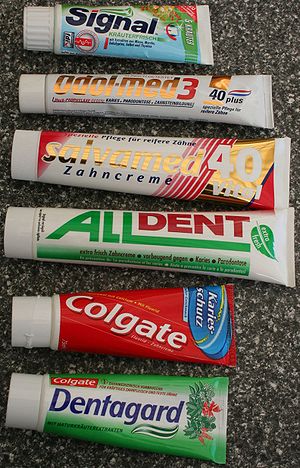Ever tried brushing your teeth without toothpaste? You will be surprised!
Dentifrices – more commonly known as toothpaste, is a type of cleaning medium
which is meant to be used together with a toothbrush to remove soft deposits on tooth surfaces. Formation of soft deposits like dental plaque is inevitable because they are produced by non-harmful bacterial flora which occupies and lives in the mouth of a normal healthy person. In fact, dental plaque provides a suitable habitat for bacteria to multiply and produce acidic by-products which is harmful to our teeth/gums. Hence, the main objective of brushing teeth is to remove such potential harmful cause and
maintain the hygiene of the oral cavity.
“Brush twice a day: before and after sleepâ€. That’s what we were told in elementary schools and during our regular dental visits. But why with dentifrices? Or perhaps better known as toothpastes.
Although the cleaning process of the oral cavity is generally contributed by mechanically means of a toothbrush, the cleaning process could be greatly enhanced with the aid of toothpaste. To understand the functions of the toothpaste, one should know the common ingredients available in a toothpaste (take note that ingredients differ from different brands, some ingredients might be absent in certain brands, which does not necessarily mean it is inferior to other brands):
- Fluoride
- Desensitizing agent
- Abrasives
- Base (alkaline chemicals)
- Foaming agent
- Antibacterial agents
- Tooth whitener
- Flavouring
Fluoride
- Available in Sodium Fluoride or Sodium Monofluorophosphate
- Active ingredient in toothpaste
- Prevents decay by incorporating into the enamel crystals which strengthens the tooth
- Rebuilds demineralised enamel crystals (early carious lesions)
- No ill effects due to fluoride deficiency, but over consumption would cause toxicity. Hence toothpastes are not made to be swallowed.
Desensitizing agent
- Available as Strontium chloride / Potassium Nitrate
- Also an active ingredient
- Reduces sensitivity of the tooth by accelerating the formation of dentine inwards which makes the tooth thicker. (only visible using X-ray)
- Does not reduce sensitivity caused by gum diseases.
- Available in toothpastes like ‘Sensodyne’.
Abrasives
- Available as Hydrated Silica / Mica
- Polishes the tooth surface
- Removes stains
- Occurs by causing minor enamel erosion (in micrometersÂ)
Foaming Agent
- Available as Sodium Lauryl Sulfate
- Adds comfort to tooth brushing.
- Also possesses strong antimicrobial properties.
- Awful taste (which will be masked by flavouring)
Antibacterial and antifungal agent
- Triclosan
- Chlorhexidine
Base
- Such as Sodium Hydroxide
- Alkaline chemical – to neutralize the acid produced by bacteria in dental plaque.
- Demotes demineralisation of enamel/dentine.
Tooth whitener
- Available as Titanium Dioxide / Hydrogen Peroxide
- Tooth whitening effect, works by bleaching
Artificial Sweeteners
- Available as Sorbitol /Saccharin
- These are complex sugars which can’t be consumed by bacteria. Because sugar promotes bacterial growth
Flavouring
- Commonly available in mint flavour.
- There is some other exotic flavouring available too such as peanut butter, ginger, and whiskey!
- It also helps in the elimination and/or masking of halitosis (bad breath)
Toothpaste is available in several forms, as its name suggest, it is commonly available in paste form. Gel and powder form are also available in the market. There is another type of toothpaste which is gaining its popularity in recent years – Herbal toothpaste. Herbal toothpaste doesn’t contain any synthetic compounds and considered to be an organic product. Though the absence of fluoride kind of defeats its purpose, individuals with allergy to mint or more commonly sodium lauryl sulphate, are suitable candidates to use them.
Conclusion
It is important to understand that excellent oral hygiene can be achieved by merely using the proper tooth brushing technique and skilled manual dexterity of an individual — regardless of toothpaste and toothbrush used. Toothpaste is just an adjunct to facilitate the cleaning process of the oral cavity, but strongly recommended by dental practitioners as it is a very effective measure in fighting against dental decay.

